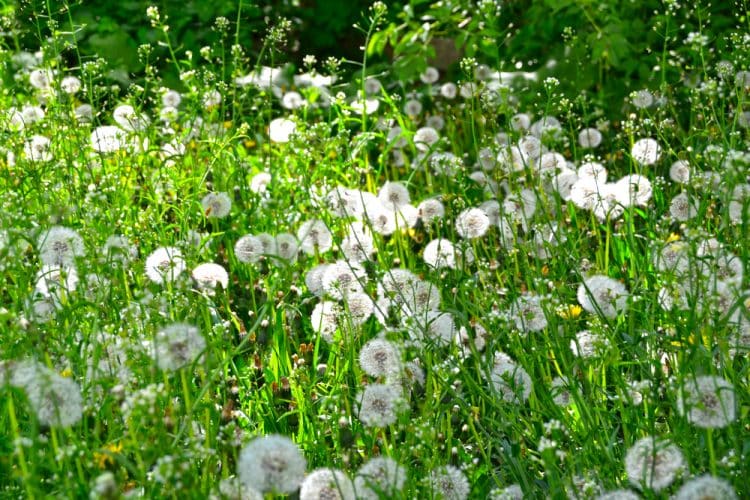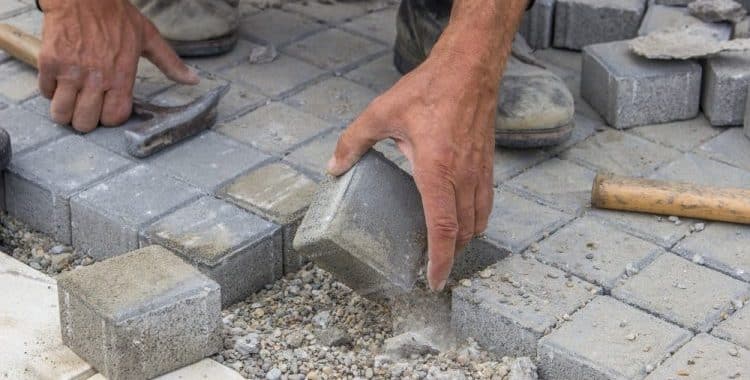We let a section of our lawn go wild and cut little paths through the tall grass and wildflowers – it looks lovely and the bees and butterflies love it too. So do lawns just keep on growing?
Lawns can reseed themselves, and it takes two months for most lawn grass varieties to produce seed heads. These heads then disperse naturally or with help from a mower, and take 7-30 days to germinate given enough moisture, sunlight, and heat.
In this article, we’re going to look at the lawn reseeding process in more detail – and consider what the benefits and drawbacks of letting your grass grow could be…

Can Lawns Reseed Themselves?
Yes, lawns can reseed themselves. Lawns add to the beauty of your entire property. Dense and continuous grass growth is more appealing. To achieve this, you need to follow a relatively simple concept—allow lawns to reseed themselves.
Each type of grass will thrive and reseed under optimum conditions. Moisture, sunlight, and temperature are essential for grass to reseed. Hence maturity of grass will not occur in all seasons.
With all the parameters right, grass grows tall and produces more blades, leading to flowering and seeding. Most lawn grasses have male and female flowers on the same plant. Transfer of lawn grass pollen is usually through wind and insects such as bees.
Seeds form when fertilization takes place in the ovaries of the female flowers. Leave the seeds on the lawn for them to germinate. The lawn grass can sometimes grow as tall as one foot before it goes to seed.
Ensure that your homeowner’s association or municipality council laws allow this before you let your lawn grass reseed. Most of your neighbors will also not appreciate an overgrown lawn that resembles a livestock patch in their street. And the insects your flowering grass will attract may also not sit well with many of your neighbors either.
How Long Does it Take For Grass To Reseed Itself? (Left On Its Own)
It takes one to two months before most lawn grasses flower and produce oval-shaped seed heads. Seeds will form closer to fall, and even then, you have to wait at least a month before seeds germinate inside the seed head.
Lawn grass seeds take anywhere from 7 to thirty days for germination to take place. For instance, fescue grass takes 14 days while Kentucky bluegrass takes 14 to 30 days. Not all grass seeds will germinate at the same time.
Once the seeds are ready, you need to cut the tops off and disperse the seeds. A lawnmower with a side blower comes in very handy for this task. Don’t cut more than a third of the total length of the grass, as it may not rejuvenate if you remove too much. Raise the blade appropriately, depending on the size of your grass.
Cut the grass in intervals of 5 days until you reach your desired height. Rake to ensure the seeds don’t stay on top but fall and fill the bald spots on your lawn.
So after planting, ensure all the necessary conditions are present for germination to occur. These conditions include warmth, water, and enough air.
If you wait for more than 30 days and nothing is happening on your patch, you need to go back to the drawing board and see what you missed. It may be the conditions are not suitable, or your seeds are not viable.
Will Grass Spread To The Bare Spots By Itself?
It depends on the type of grass you have on your lawn. Some types of grass can spread and fill bare spots through the spread of rhizomes and stolons. Rhizomes are underground stems developing from the lawn grass mother plant, while stolons are found above ground. They will move very far to find any bald spots on your lawn and fill them.
However, most lawn grass does not propagate through rhizomes but seeds. Kentucky bluegrass, zoysia, centipede, Bermuda, and St. Augustine are grasses spread through rhizomes and stolons.
Lawn grasses that require seeds to propagate will fill the bald spots once the grass reaches the seeding stage without being mowed. Raking helps to spread the seeds to the bald areas of the lawn. So, yes, even this type of grass may spread by itself to bald spots.
How Do You Get Grass To Reseed Itself? (By Helping)
While allowing grass to grow taller may create an unsightly lawn, it’s one way of getting grass to reseed itself. So you do not have to mow your lawn for a while as you let your grass blossom.
When the lawn is not mowed, the grass develops seeds. The seed heads develop at the top when the grass blades mature. Eventually, the grass reseeds itself with the same type of grass.
Do some raking to expose the dirt to the seeds. Raking helps in the removal of any thatch formation, allowing seeds to settle on the soil. To avoid dislodging seeds from the blades, ensure you rake the lawn before seed heads develop.
Seeed heads are oval-shaped, and they sprout once the grass grows uninhibited.
The growth process might take one or two months to full maturity. You will see the seeds within a month or so.
Use a lawnmower with a side blower to help scatter the seeds on your lawn during the mowing process. The rule of thumb is to cut only a third of the blade. For example, you can only cut 2 inches off a six inches tall blade.
Once you are through with the mowing, you can take to ensure the seed falls into the bald spots. You then need to water the grass. Subsequently, you need to water your seeds for about thirty minutes a day at least.

Is it Bad To Let Your Lawn Go To Seed?
There are potential dangers in allowing your lawn to seed:
It Affects Weed Control
Weeds are one of the thorns in the flesh of a beautiful lawn. Nonetheless, you need to take care of them. When you allow lawns to go to seed, you also allow weeds to grow.
Regular mowing keeps weeds under wraps. They are weakened through mowing.
Weakening of the Grass
This happens if you do not apply the one-third rule. If you ask folks why they mow their lawns, they’d probably tell you it is because of beauty and avoiding neighbors’ complaints. If you do not mow your lawn, the grass grows excessively.
In worst-case scenarios, the seed from the overgrown grass could be sterile. If much of the seeds that develop from mature grasses aren’t fertile, filling patches could take longer than expected.
Seed creation extracts energy from grass. Typically, creating seeds takes a lot of energy from the grass. When you allow your lawn to go to seed, it diverts energy. Healthy lawns need strong blades.
Also, when the grass is focused on flowering, it produces fewer rhizomes crucial in repairs. Over time the lawn looks awful.
Irritate the Neighbors
Some neighbors may complain when you let your grass grow tall. They may even report you to the neighborhood association.
The Benefits of Letting Your Grass Go To Seed
Here are the benefits of letting your grass go to seed:
No Browning in the Summer
When your grass is cut often, it tends to turn brown during the summer. So when the grass is watered, it is usually mud. But when the long grass is watered, it turns green quickly. It also helps to prevent bald spots as the seeds regerminate to fill empty spaces.
Saves Cost of Replanting Bald Spots
When you let your grass go to seed, you can spread the seeds to bald areas. The seeds will grow and cover the empty spaces. This will save you the cost of buying grass to plant in such areas.
Attracts Bees
Bees are attracted to flowering grass. Globally bees are endangered, so having long grass helps in the pollination process and offers a great benefit to the environment.
Summary
Whether you choose to help the process along or not, your lawn can definitely reseed itself – giving you a lovely natural garden of long grass and wildflowers in the process.
Your family, friends and bugs such as bees and butterflies will love your naturally seeded lawn, but your neighbors and housing association may not – so make sure you find out the rules on not mowing your lawn before you let it go crazy.
Our view is that you should do both if you can – meaning that we have areas of both traditional mown lawn and other sections of the yard that have free-growing wild grasses and flowers. It’s your backyard though so the choice is always yours. 🙂



